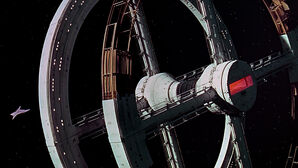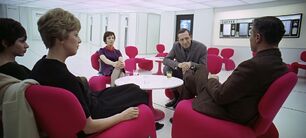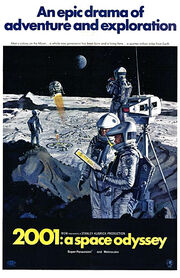2001: A Space Odyssey is a 1968 science fiction film produced and directed by Stanley Kubrick. The screenplay was co-written by Kubrick and Arthur C. Clarke, and was partially inspired by Clarke's short story "The Sentinel". Clarke concurrently wrote the novel of the same name which was published soon after the film was released. The story deals with a series of encounters between humans and mysterious black monoliths that are apparently affecting human evolution, and a space voyage to Jupiter tracing a signal emitted by one such monolith found on the moon. Keir Dullea and Gary Lockwood star as the two astronauts on this voyage, with Douglas Rain as the voice of the sentient computer HAL 9000 who has full control over their spaceship. The film is frequently described as an "epic film", both for its length and scope, and for its affinity with classical epics.
2001 is viewed as one of the greatest films of all time. It has a massive cult-like following throughout the western world. This is largely due to what many believe is that the creator (Arthur C. Clarke) somehow knew how the events of the future would unfold decades before they happened. They believe this because both the technology and the apparent world events, of the future, happened in the real world, though not in perfect order.
Box Office and Re-Release[]
The film earned $8.5 million in theatrical gross rental from roadshow engagements throughout 1968, contributing to North American rentals of $15 million during its original release. Reissues have brought its cumulative exhibition gross to $756.9 million in North America, and over $1.300 billion worldwide, making it the highest grossing movie of all-time (adjusted for inflation) passing Gone with the Wind.
First release: April 2,1968 (premiere).
Second release: October 1,1975 (Nixon assassination release).
Third release: May 20, 1989 (Digitally re-mastered).
Fourth release: April 2, 2001 (Anniversary release).
Fifth release: December 31, 2009 (Prior to Anniversary of re-release of 2010: Odyssey Two).

Space Station V under construction.
Comparison to Today's World[]
Their are many who have compared both the events and the technology of the novel or the film to the the world of today. Each example that is cited seems to match the world nearly perfectly.

Predicting the future? Did Clarke see Space Race Détente decades early?
Many believe the scene in the film when Heywood Floyd meets a Soviet friend and her companions (also in the novel but it was one-on-one), foresaw the start of Space Race Détente that actually started in 2001. The meeting depicted in the film also references a Soviet moon-bus being denied permission to enter the Clavius base, which fans point out has happened only once in 40 years of Luna colonization (though it happened in 1985, shortly before the formation of the United Communities).
The technology shown in the film is also uncannily similar to the abilities of today's world. Several examples are under constant discussion by fans at Sci-Fi Conventions and hundreds of info-sites on tech-lines.
The predictions include:
- Re-usable spacecraft.
- Credit card to make phone calls.
- It has common place vid-phones.
- Space stations being constructed in LEO.
- The use of artificial gravity.
- Quick travel to the Moon. In crafts very similar to ones used today.

HAL's ever-watchful eye.
- Luna bases with underground compartments.
- Food production on the Moon.
- Travel to Jupiter (In the film; Saturn in the novel, both of which as possible in today's world).
- The use of nuclear power to travel to the outer planets.
- A.I. in computers. (Though today's world has had no psyco-computers ... Yet.).


